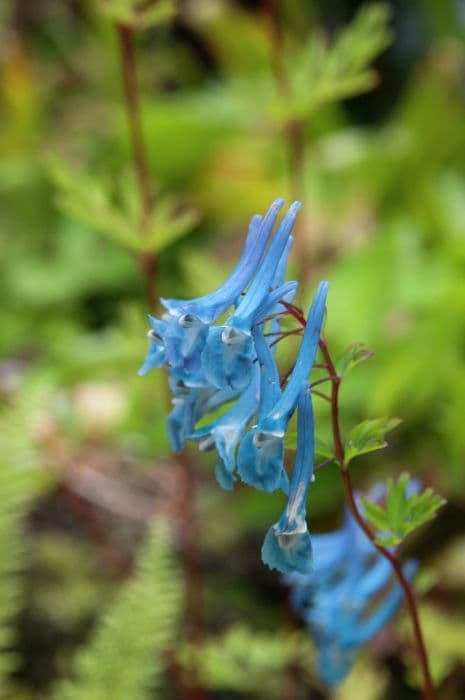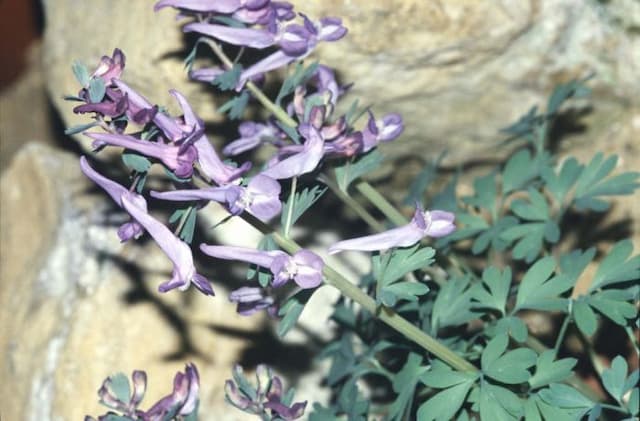Frying Pan Poppy Eschscholzia lobbii 'Sunbeam'

ABOUT
The 'Sunbeam' variety of California poppy boasts bright, sunny yellow flowers that are a radiant addition to any garden. The petals of these charming blooms are delicate and silky to the touch, showcasing a golden hue that can light up the space they inhabit. The center of each flower is adorned with a soft cluster of stamen that contrast subtly with the vibrant petals. This version of the California poppy typically has a more cup-shaped bloom, channeling the essence of a miniature sun. Its foliage is also noteworthy, formed of blue-green leaves that are finely divided into narrow segments, giving them a feathery, almost fern-like appearance. The leaves form a lush, compact mound which cradles the flowers on slender stems that rise just above the foliage. The plant as a whole exudes a light, airy feel, which makes it an excellent choice for a natural or wildflower garden setting. Overall, the appearance of the California poppy 'Sunbeam' encapsulates the joy and warmth of a sunny day, with its bright yellow blooms serving as little bursts of sunshine regardless of the weather. Its soft foliage complements the cheerful flowers, rounding out a plant that is as elegant as it is vibrant.
About this plant
 Names
NamesFamily
Papaveraceae.
Synonyms
Frying Pans, Sun Cups, Yellow Poppies.
Common names
Eschscholzia lobbii 'Sunbeam'.
 Toxicity
ToxicityTo humans
Frying pans, also known as Eschscholzia lobbii, have not been widely reported to be toxic to humans. However, it is always prudent to exercise caution and avoid ingesting plants not known or confirmed to be safe. If any part of the plant is ingested and an adverse reaction occurs, seek medical attention.
To pets
Frying pans, also known as Eschscholzia lobbii, have not been widely reported to be toxic to pets. Nonetheless, it is always a good practice to prevent pets from eating ornamental plants. If a pet ingests any part of the plant and shows signs of illness, consult a veterinarian.
 Characteristics
CharacteristicsLife cycle
Annuals
Foliage type
Deciduous
Color of leaves
Green
Flower color
Yellow
Height
1 foot (30 cm)
Spread
1 foot (30 cm)
Plant type
Herb
Hardiness zones
6
Native area
California
Benefits
 General Benefits
General Benefits- Attracts Pollinators: Eschscholzia lobbii 'Sunbeam' encourages bees, butterflies, and other beneficial insects to visit, promoting pollination in the garden.
- Drought Tolerant: Once established, it requires minimal watering, making it suitable for xeriscaping or areas with water restrictions.
- Low Maintenance: With no major pruning or special care needed, it's ideal for both novice and experienced gardeners.
- Aesthetic Appeal: Its bright, cheerful flowers add vibrant color to garden beds, borders, and containers.
- Fast Growing: The plant quickly reaches maturity, meaning you don't have to wait long to enjoy its full beauty.
- Resistant to Pests: It's not typically prone to infestation or disease, reducing the need for chemical treatments.
- Adaptable: It can thrive in a variety of soil types, as long as the location offers full sun exposure.
- Enhances Biodiversity: By providing nectar and habitat, it supports local ecosystems and biodiversity.
- Ground Cover: Can be used to provide a natural cover that suppresses weeds and controls soil erosion.
 Medical Properties
Medical PropertiesThis plant is not used for medical purposes.
 Air-purifying Qualities
Air-purifying QualitiesThis plant is not specifically known for air purifying qualities.
 Other Uses
Other Uses- Photographic subject: The vibrant petals of the Sunbeam can be ideal for macro photography enthusiasts looking to capture the intricate details of flower anatomy.
- Natural fabric dye: The pigments from the Sunbeam's flowers can be used to create a natural dye for textiles, offering a range of yellow to orange hues.
- Educational tool: The plant can be used in school gardens to teach students about the growth cycle of flowering plants and pollination.
- Artistic inspiration: The Sunbeam's bright flowers often inspire artists and can be used as live models for paintings and floral designs.
- Culinary decoration: The petals can be used as a colorful, edible garnish on salads and desserts, although one should ensure they are safe and pesticide-free before consumption.
- Jewelry making: Dried petals can be incorporated into eco-friendly jewelry, such as resin pendants or pressed flower earrings.
- Floral confetti: Dried petals can be used as biodegradable confetti at events, offering an environmentally friendly alternative to traditional paper or plastic confetti.
- Garden design: The plant can be used in xeriscaping, which is a landscaping method that reduces or eliminates the need for irrigation.
- Companion planting: Sunbeam can be planted alongside vegetable crops to attract pollinators, potentially increasing the yield of vegetables that require pollination.
- Scented sachets: Dried Sunbeam flowers can be added to sachets to provide a natural fragrance for drawers and closets.
Interesting Facts
 Feng Shui
Feng ShuiThe California poppy is not used in Feng Shui practice.
 Zodiac Sign Compitability
Zodiac Sign CompitabilityThe California poppy is not used in astrology practice.
 Plant Symbolism
Plant Symbolism- Beauty: As a vibrant flower, the California Poppy signifies beauty in its purest form, showcasing the natural aesthetics of the floral world.
- Sleep and relaxation: Due to its mild sedative properties, historically used to promote sleep, the California Poppy is associated with relaxation and rest.
- Resilience: California Poppies can thrive in harsh conditions, representing the human capacity to cope with difficulty and adversity.
- Remembrance: Similar to other poppies, the California Poppy serves as a symbol for remembrance, particularly for those lost in wars.
 Water
WaterFor the Frying Pan Poppy, water moderately, ensuring the soil remains moist but not waterlogged. During the growing season, watering once per week with about 0.25 gallons per square foot is typically sufficient, but adjust according to weather conditions; allow the topsoil to dry out slightly between waterings. Decrease the frequency in cooler months or during rainy periods to prevent root rot. Always avoid overhead watering to reduce the risk of disease and instead water at the base of the plant.
 Light
LightFrying Pan Poppy thrives in full sun conditions, with at least 6 to 8 hours of direct sunlight every day. The best spot for these plants is a location that receives uninterrupted sun exposure throughout the day to ensure vigorous growth and abundant blooming. Partial shade can be tolerated, but flowering may be reduced.
 Temperature
TemperatureFrying Pan Poppy does well in a temperature range of 50 to 85 degrees Fahrenheit. It can withstand short periods of colder temperatures down to 32 degrees Fahrenheit, but prolonged exposure to freezing conditions can be harmful. The ideal temperature for optimum growth is between 60 and 70 degrees Fahrenheit.
 Pruning
PruningPrune Frying Pan Poppy after flowering to promote a tidy appearance and to encourage a potential second bloom. Cut back the spent flower stems to the base of the plant. Annually, trim back any dead or damaged foliage in late fall or early spring to maintain plant health and vigor.
 Cleaning
CleaningAs needed
 Soil
SoilFryer's Poppy thrives in well-draining soil with a pH range of 6.0 to 7.5. A soil mix consisting of equal parts loamy soil, sand, and peat moss, or a commercial cactus mix, is ideal. Ensure good drainage to prevent root rot.
 Repotting
RepottingFryer's Poppy, being an annual, does not typically require repotting as it completes its lifecycle within one growing season. Instead, sow seeds annually in a suitable location.
 Humidity & Misting
Humidity & MistingFryer's Poppy prefers drier conditions and is tolerant of low humidity environments, making it suitable for typical outdoor conditions in its growing zones.
 Suitable locations
Suitable locationsIndoor
Needs full light, well-draining soil, minimal water.
Outdoor
Full sun, well-drained soil, water sparingly.
Hardiness zone
5-9 USDA
 Life cycle
Life cycleThe 'Sunbeam' California Poppy (Eschscholzia lobbii 'Sunbeam') begins its life cycle as a seed, which germinates in late winter or early spring when the temperature and moisture conditions are favorable. Upon germination, the seedling emerges with its cotyledons (seed leaves), which will soon give way to true leaves as the plant enters the vegetative growth stage. During this period, the plant develops a taproot and starts to grow its distinctive blue-green, finely divided foliage. As the plant matures, it transitions to the flowering stage, usually in late spring to early summer, producing small, cup-shaped, lemon-yellow flowers that attract various pollinators. After pollination, the flowers develop into elongated seed pods, which will eventually dry and open to release seeds, completing the reproductive cycle. The 'Sunbeam' California Poppy has an annual lifecycle, meaning it will go through its entire growth process, from seed to seed, within one growing season and then die, leaving behind seeds to start the next generation.
 Propogation
PropogationPropogation time
Spring-Early Summer
The Frying Pan Poppy, commonly known as Eschscholzia lobbii 'Sunbeam', is most commonly propagated by seeds. The optimal time for sowing seeds is either in the fall or early spring. To propagate, simply scatter the seeds across well-drained soil where you desire the plants to grow. The seeds should not be buried deep, as they require some light to germinate effectively. Just pressing them gently into the soil or sprinkling a very thin layer of soil over them is sufficient. Water the area lightly to ensure the soil is moist but not waterlogged. Germination usually occurs when temperatures are within the range of 55 to 65 degrees Fahrenheit (13 to 18 degrees Celsius), but seeds can also germinate in cooler temperatures.









